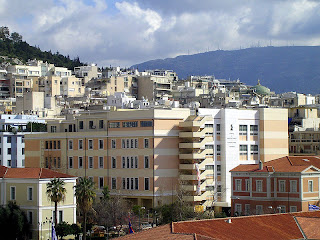The Ranking of University of Athens, Greece
Ranked 200th in the world, the National and Kapodistrian University of Athens (Greek: Εθνικόν και Καποδιστριακόν Πανεπιστήμιον Αθηνών), usually referred to simply as the University of Athens, is the oldest university in Greece and has been in continuous operation since its establishment in 1837. Today, it is the second-largest institution of higher learning in Greece (the largest is the Aristotle University of Thessaloniki), with more than fifty thousand undergraduate students.
 History
History
The National and Kapodistrian University of Athens was founded on May 3, 1837, and was housed in the residence of architect Stamatis Kleanthes, on the north east side of the Acropolis. It was the first University not only in the newly- established Greek State but in all the Balkans and the Eastern Mediterranean in general.
Before it was renamed to honour Ioannis Kapodistrias, the first head of state of independent modern Greece, the university was known as the Othonian University and consisted of four faculties; theology, law, medicine and arts (which included applied sciences and mathematics). It had 33 professors, 52 students and 75 non-matriculated “auditors”. In November 1841, classes began in a new building, “the Propylaea”, designed by the Danish architect Theophil Hansen.
A major change in the structure of the University came about in 1904, when the faculty of Arts was split into two separate faculties: that of Arts and that of Sciences, the latter consisting of the departments of Physics and Mathematics and the School of Pharmacy. In 1919, a department of chemistry was added, and in 1922 the School of Pharmacy was renamed a Department. A further change came about when the School of Dentistry was added to the faculty of medicine.
In this first and “heroic” period for Greek education, the university faculty made great efforts to fill the gap between their newly founded institution and older ones in other countries.
Between 1895 and 1911, an average of one thousand new students entered the faculties each year, a figure which rose to two thousand at the end of World War I. This led to the decision to introduce entrance examinations for all the faculties, beginning in the academic year 1927-28. Since 1954 the number of students admitted each year has been fixed by the Ministry of Education and Religion, on the proposal of the faculties.
In the 1960’s construction work began on the University Campus in the suburb of Ilissia. The Ilissia campus now houses the Schools of Philosophy, Theology and Sciences.

The main campus is in Ilissia (Zografou), where the schools of Science, Theology and Philosophy are located. Other smaller campuses are at Goudi, where the faculty of Health Sciences is located, and at Daphne, where the faculty of Physical Education and Sports Science is located. The faculties of Media, Education, Economics, Law and Public Administration are housed in buildings in the centre of Athens, along with various administration facilities. The historical administration building is also located there, on Panepistimiou avenue.

Research in the University of Athens is intimately linked with that conducted in the hospitals and research institutes of the metropolitan area, including the National Research Center for Physical Sciences Demokritos, the National Research Foundation (EIE), the National Observatory of Athens, the Hellenic Pasteur Institute, the Alexander Fleming Biomedical Sciences Research Center, the Athens High Performance Computing Laboratory, the National Centre for Marine Research (NCMR) and the Foundation for Biomedical Research of the Academy of Athens (IBEAA). Research conducted in the institutes of the metropolitan area of Athens accounted for over 50% of the ISI-indexed scientific publications coming from Greece in 2004.

The University of Athens is divided into schools, faculties and departments as follows. The naming is nοt consistent in English for historical reasons, but in Greek the largest divisions are generally named “σχολές” (schools) and are divided in “τμήματα” (departments), furthermore subdivided in “τομείς” (divisions)
School of Theology
Faculty of Theology
Faculty of Social Theology
School of Philosophy
Faculty of Philology
Faculty of History and Archaeology
Faculty of Philosophy, Pedagogy and Psychology
Faculty of English Studies
Faculty of French Language and Literature
Faculty of German Studies
Faculty of Italian and Spanish Language and Literature
Faculty of Theatre Studies
Faculty of Music Studies
Faculty of Turkish and Modern Asian Studies
Faculty of Slavic Studies
Schools of Health Sciences
Faculty of Medicine
Faculty of Dentistry
Faculty of Pharmacy
Faculty of Nursing
School of Law, Economics and Political Sciences
Faculty of Law
Faculty of Economic Studies
Faculty of Political Science and Public Administration
School of Sciences
Faculty of Physics
Faculty of Biology
Faculty of Geology and Geoenvironment
Main article: Faculty of Geology and Geoenvironment (University of Athens)
Faculty of Chemistry
Faculty of Mathematics
Faculty of Informatics and Telecommunications
Independent faculties
Faculty of Physical Education and Sport Science
Faculty of Primary Education
Faculty of Early Childhood Education
Faculty of Communication and Mass Media Studies
Faculty of Philosophy & History of Science



0 Comments:
Post a Comment